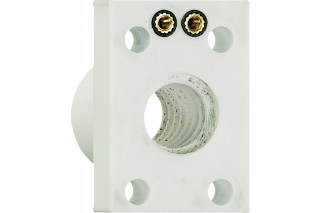Change Language :
Intelligent 3D-printed wear-resistant parts
Integrated sensors indicate maintenance and issue warning before overloading occurs
The engineers in the igus 3D printing team have now achieved a further great step: sensors are printed into the tribo component via multi-material printing. Long before the failure, it signals that a replacement is imminent. Furthermore it is possible to detect an overload so as to initiate an immediate machine stop and thus prevent further damage to the bearing point and the entire machine. This enables predictive maintenance for special parts as well, with the result that machine downtime and maintenance work can be reduced. Due to additive manufacturing, such intelligent 3D isense components can now be delivered in a cost-effective way from five business days.
3D isense is suitable for the manufacture of intelligent plain bearings, sliding elements, lead screw nuts and all other special parts that are susceptible to friction and wear.
Development

igus engineers work on researching and developing materials and procedures for developing intelligent 3D printing components.
igus has been developing intelligent wear-resistant parts since 2016, and is by now using them in energy chains, plain bearings and linear guides. When designing these wear sensors, our developers have been using the igus 3D printing service for wear-resistant parts. That way, special gliders have been manufactured via laser sintering and made of iglidur I3; the intelligence was incorporated afterwards in a second process step.
This has lead to the intelligent special parts being very complex and cost-intensive when produced in small numbers, as the downstream work steps are very specific and tailored to the individual component. The 3D printing developers accepted this challenge and came up with a procedure for producing such intelligent wear-resistant parts in one work step via 3D printing. Now, as no further processing steps are necessary, intelligent special wear-resistant parts can be manufactured cost-efficiently from five working days on.
Function explained

Due to 3D printing, wear-resistant can be designed according to your wishes and made intelligent
During printing, the sensor layer is applied to those parts of the component that will be subjected to load. When in use, the electrical resistance of the sensor material is measured continually so that a warning is issued before overloading or before the wear limit is reached.
Based on the procedure for multi-material printing, wear-resistant parts with integrated sensor layers are developed. The components are made from the wear-resistant filaments iglide I150 or iglide I180 and a specifically developed electrically conductive 3D printing material that sticks well to the tribofilament.
Two application areas:
► Warning before overload occurs: The electrically conductive material is situated between the wearing layers. If the load changes, the resistance also changes. To determine the load limits, the bearing has to be calibrated correspondingly.
► Reaching of the wear limit: the conducting path is located in the gliding surface, the wear is measured via the der change of the resistance.



